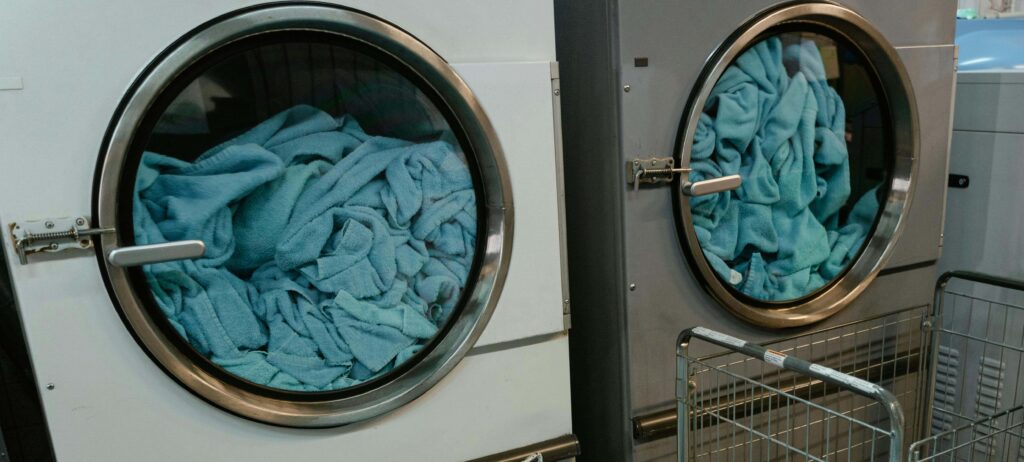Running Your Dryer Vent to the Outside Wall

Most of us do laundry on a weekly basis, and unless you still use a good old-fashioned clothesline to dry your linens, then you probably use a dryer. And let’s face it – nothing beats warm, clean clothes fresh out of the dryer. But for all of the clothes that go into the dryer, it’s easy to forget that your dryer doesn’t just dry your shirts and pants: your dryer also traps and removes excess lint and moisture. Despite what you might think, the efficiency of your dryer vent depends mostly on how the dryer vent ductwork is installed. You’ll often see the term “High-efficiency dryer” when shopping for a new dryer, but this is actually just a marketing term and does not necessarily make your dryer more effective than any other dryers. One of the keys to dryer efficiency is how well your dryer vent blows moisture and heat to the exterior of the home through ductwork.
Whether you are installing a new dryer, or adding a dryer in a new location in your home, there are a few recommendations on how to run your dryer vent to the outside wall, and a few basic rules to keep in mind in order to maintain efficiency and safety when running your dryer.
Planning Where the Dryer Vent Ductwork Will Go:
Before the work of installing dryer ductwork even begins, you will want to plan out where your dryer ductwork is going to be placed from the exhaust port on the back of your dryer all the way to the outside wall. Most building codes will stipulate that a typical 4-inch diameter duct run for a dryer should not exceed 25 feet – that is the maximum length the duct run from the dryer to the outside wall can be.
You’ll want to avoid working against gravity. The duct run should be installed in a horizontal path to the outside, if at all possible. This will help prevent clogs and moisture buildup within the ductwork. Even still, it is recommended that for every foot of duct run, your pipe should drop 1/4 inch, so that the duct is angled slightly downwards. Also, remember to account for any appliances, wall studs, fixed furniture, or any other obstacles in the path of the duct run. For every turn the ductwork has to take, you have to reduce the maximum allowed length of the duct run – this means 2-1/2 feet less for every 45-degree turn, and 5 feet less for every 90-degree turn. With only 25 feet of run to begin with, each turn can add up quickly!
Should You Use Flex Duct or Rigid Duct For Your Dryer Vent?
Once you know where the duct will go, you will want to select the right ductwork for the job. Most dryers have a connection for 4-inch duct, but what kind of duct should you use for dryer ventilation?
Flex duct is a wire coil inside of a bendable plastic tube, usually insulated with fiber glass. While flex duct is relatively cheap and can be bent to fit any given pathway, it is also prone to lint build up, tearing, and airflow issues. You should avoid using flex duct with a dryer vent if at all possible, since it could pose a fire risk. Even if it is cheap and convenient, just say NO to this danger noodle!
Rigid duct is a much better option for dryer venting – it is a solid tube, typically made of Aluminum, which is very heat resistant, and the smooth inner pipe is optimal for good airflow. Rigid duct sections can be connected together and go around corners using elbows. We say YES to this trusty tube!
Clean? Yes. Screen? No.
Now that you have your Dryer, your game plan, and your Ductwork, it’s time to choose a Dryer Vent Hood. Because you want to prevent backdrafts and invasive pests, it is typically recommended that you choose a dryer vent that includes a built-in damper. The damper is designed to open from the airflow of the running dryer, and closes when airflow stops. The damper can also be lifted to access the ductwork for when it comes time to clean your dryer vent ductwork. It is recommended that you clean your dryer vent ducts once per year to prevent the buildup of lint.
You do not, however, want to get a wall vent that has any sort of screen attached. Screens collect lint, and can clog or reduce airflow, which could pose a fire risk. Many wall vents for bathroom fans and kitchen range hood exhaust will come with a built in screen, so you will want to be sure to purchase a dryer vent hood that does not have any sort of screen. Be sure to check out our step by step guide on how to install a dryer vent.





